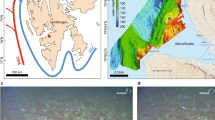Abstract
Four of the most abundant gorgonian species from the southwestern Cape waters, Eunicella papillosa (Esper, 1797), E. alba (Esper, 1797), E. tricoronata Velimirov, 1971 and Lophogorgia flamea (Ellis and Solander, 1786) were analysed for Ca and Mg by atomic absorption spectroscopy (AAS) and ethylenediaminetetraacetate (EDTA) titration. The total mineral content in the peripheral tissues, excluding the axial skeleton, expressed as the sum of CaCO3 and MgCO3 of dry matter was between 65.5 and 83.5%. The mineral content varied in different growth regions and all specimens showed a higher degree of mineralization at the base than at the branch tips. The MgCO3 concentration varied with genus and species and was between 9 and 11 mol %. The variation of the MgCO3 concentration within different growth regions of the same species was small and generally did not exceed 0.8 mol %. From the branch to the stem, CaCO3 and total mineral content was found to increase. The CaCO3:MgCO3 rations in different growth regions of all species indicated that the composition of the mesoskeleton with regard to the relative concentration of CaCO3 and MgCO3 is constant throughout the animal. Mineralogically, the mesoskeleton consists of high magnesian calcite as identified by X-ray diffraction. MgCO3 concentrations determined by the peak shift method and by AAS were in fair agreement. The MgCO3 data in gorgonian samples from the cold Atlantic Ocean and the warmer Indian Ocean show a linear relationship between water temperature and MgCO3 concentration already demonstrated by Chave (1954). However, our data were consistently lower by 1 to 2% than expected.
Similar content being viewed by others
Literature Cited
Andrews, W.R.H. and D.L. Cram: Combined aerial and shipboard upwelling survey in the Benguela Current. Nature, Lond. 244, 902–904 (1969)
Balard, M.: Note pour servir à l'histoire naturelle de l'iode. Annls Chim. Phys. (Ser. 2) 28, 178–181 (1825)
Bang, N.D.: Oceanic environment of South Africa. Stand. Encycloped. S. Afr. 8, 282–286 (1973a)
—: Characteristics of an intense ocean frontal system in the upwelling regime west of Cape Town. Tellus 25, 256–265 (1973b)
Bisque, R.E.: Analysis of carbonate rocks for calcium, magnesium, iron and aluminium with EDTA. J. Sedim. Petrol. 31, 113–122 (1961)
Block, R.J. and D. Bolling: The amino acid composition of keratins. The composition of gorgonin, spongin, turtle scutes and other keratins. J. biol. Chem. 127, 685–693 (1939)
Böhm, E.L.: Studies on the mineral content of calcareous algae. Bull. mar. Sci. 23, 177–190 (1973)
Bütschli, O.: Untersuchungen über organische Kalkgebilde nebst Bemerkungen über organische Kieselgebilde. Abh. Akad. Wiss. Göttingen (Math.-Phys. Kl.) 6 (3), 1–177 (1908)
Cary, L.R.: The Gorgonacea as a factor in the formation of coral reefs. Publs Carnegie Inst. 213, 341–362 (1918)
Chave, K.E.: Aspects on the biogeochemistry of magnesium. 1. Calcareous marine organisms. J. Geol. 62, 266–283 (1954)
Clark, F.W. and W.C. Wheeler: The inorganic constituents of marine invertebrates. Prof. Pap. U.S. geol. Surv. 124, 1–62 (1922)
Darbyshire, J.A.: A hydrological investigation of the Agulhas Current area. Deep-Sea Res. 11, 781–815 (1974)
Dreschel, H.F.E.: Beitrãge zur Chemie einiger Seetiere. II. Über das Achsenskelett der Gorgonia cavolinii. Z. Biol. 33, 85–107 (1896)
Ellis, J. and D. Solander: The natural history of zoophytes, 208 pp. London: 1786
Esper, E.: Fortsetzung der Pflanzenthiere, 230 pp. Nürnberg: 1797
Flemming, B.W.: Rocky bank — evidence for a relict wave-cut platform. Ann. S. Afr. Mus. 71 (1976). (In press)
Ginsburg, R.N.: Environmental relationship of grain size and constituent particles in some South Florida carbonate sediments. Bull. Am. Ass. Petrol. Geol. 40, 2384–2427 (1956)
Goreau, T.F.: The physiology of skeleton formation in corals. 1. A method for measuring the rate of calcium deposition by corals under different conditions. Biol. Bull. mar. biol. Lab., Woods Hole 116, 59–75 (1959)
—: On the relation of calcification to primary productivity in reef building organisms. In: The biology of hydra, pp 269–285. Ed. by H.M. Lenhoff and W.F. Loomis. Miami: University Press 1961
Goldsmith, J.R., D.L. Graf and H.C. Heard: Lattice constants of the calcium-magnesium carbonates. Am. Miner. 46, 453–457 (1961)
Lemoine, M.P.: Structure anatomique des mélobesiées. Annls Inst. océanogr., Monaco 2, 1–213 (1910)
Marks, M.H., R.S. Bear and C.H. Blake: X-ray diffraction evidence of collagen-type protein fibres in the Echinodermata, Coelenterata and Porifera. J. exp. Zool. 111, 55–78 (1949)
Milliman, T.D.: Recent sedimentary carbonates, Part. 7. Marine carbonates, pp 1–15. Ed. by J.D. Milliman. Heidelberg: Springer Verlag 1974
Phillips, A.H.: Analytical search for metals in Tortugas marine organisms. Publs Carnegie Instn 312, 95–99 (1922)
Roche, J., S. Andre et G. Salvatore: Métabolism de l'iode et formation de la scleroproteine iodée (gorgonine) du squelette corné chez Eunicella verrucosa Pallas. C.r. Séanc. Soc. Biol. 153, 1747–1751 (1959)
—, et M. Eysseric-Lafon: Biochemie comparée des scleroproteines iodées des anthozoaries. Bull. Soc. Chim. biol. 33, 1437–1447 (1951)
Terentieva, K.F.: la composition minerale des squelettes de certaines éspèces d'echinodermes contemporaines. Trudý biogeokhim. Lab. 2, 1–45 (1932)
Velimirov, B.: Beitrag zur Systematik der südafrikanischen Gorgonien. Zool. Anz. 187, 266–273 (1971)
Velimirov, B. Variations in growth forms of Eunicella cavolinii (Octocorallia) related to intensity of water movement. J. exp. mar. Biol. Ecol. 21, (1976). (In press)
Vinogradov, A.P.: La composition chimique élémentaire des organismes vivants et le systeme périodique des éléments chimiques. C. r. hebd. Séanc. Acad. Sci., Paris. 197, 1673–1694 (1933)
—: The elementary chemical composition of marine organisms. Mem Sears Fdn mar. Res. 12, 1–647 (1954)
Author information
Authors and Affiliations
Additional information
Communicated by O. Kinne, Hamburg
Rights and permissions
About this article
Cite this article
Velimirov, B., Böhm, E.L. Calcium and magnesium carbonate concentrations in different growth regions of gorgonians. Marine Biology 35, 269–275 (1976). https://doi.org/10.1007/BF00396874
Accepted:
Issue Date:
DOI: https://doi.org/10.1007/BF00396874




